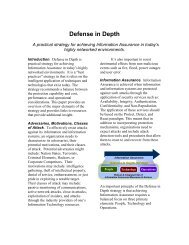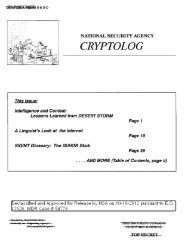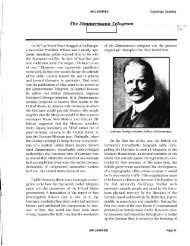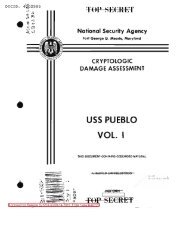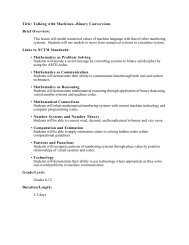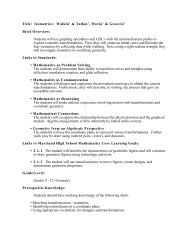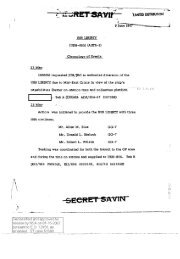Title: The Rhythm of Equations
Title: The Rhythm of Equations
Title: The Rhythm of Equations
Create successful ePaper yourself
Turn your PDF publications into a flip-book with our unique Google optimized e-Paper software.
• Say: Looking at our diagram now, can anyone tell me the attributes <strong>of</strong> an<br />
equation? Solicit student responses (numbers, variables, operation, and<br />
equal sign).<br />
• Define the following four terms and place on word wall for future use.<br />
Variable: to a letter or symbol representing such a quantity.<br />
Operation: addition, subtraction, multiplication, division<br />
Equal sign: shows a relationship <strong>of</strong> balance on both sides <strong>of</strong> the sign<br />
• Distribute construction paper or a piece <strong>of</strong> unlined paper for students to<br />
use as a work mat. Have students fold paper in half twice to make four<br />
equal size squares.<br />
• Say: We already decided that one triangle was equal to the number one.<br />
But, what if I said it is no longer equal to one and instead it is equal to<br />
three. Show on your work mat = 3. Using what we know<br />
about the relationship between the shapes, we could draw a diagram<br />
showing what the rhombus is now equal to.<br />
• Display: + = and 2* =<br />
• Rhombus= 2*triangle or Rhombus = 3+3<br />
• Point to display. Ask: This is my diagram, how can I turn my diagram<br />
into an equation. What is it missing? (A variable) Let’s use the first letter<br />
<strong>of</strong> the color <strong>of</strong> the shapes to represent the actual shape, so we will make it<br />
our variable. For example, what color is the triangle? (Green Triangle=<br />
G); What color is Trapezoid? (Red Trapezoid = R) What color is<br />
Rhombus? (Blue Rhombus =B) and What color is Hexagon? (Yellow<br />
Hexagon= Y).<br />
• Say: Now let’s turn our diagram into an equation. We want the triangle<br />
to continue to equal 5 so T=5. So if we want to find out what rhombus is<br />
equal to, we could write: T x 2= R or 5 x 2 = R. Let’s check to make<br />
sure this is an equation. What are the variables in the equation T x 2= R<br />
(T and R) What is the operation? (Multiplication) What are the numbers?<br />
(2 and/or 5) Do we have an equal sign? (Yes).<br />
• Say: On your work mat please show: 8+G = 12. Show using pattern<br />
blocks.<br />
8 + =12<br />
What number can we substitute for the G? What does the G =? (4) How<br />
do you know? (Because the only number that you can insert to make both<br />
sides equal or balanced is 4).<br />
• Say: I want you to take the eight away and substitute it with a symbol or a<br />
variable, what can you predict I will replace it with? Explain your<br />
prediction. (B or a rhombus, because the rhombus is twice the size <strong>of</strong> the<br />
triangle)<br />
• Make sure students understand the meaning <strong>of</strong> the word substitute here.<br />
Put the word Substitute on the word wall. Substitute is replacing a






